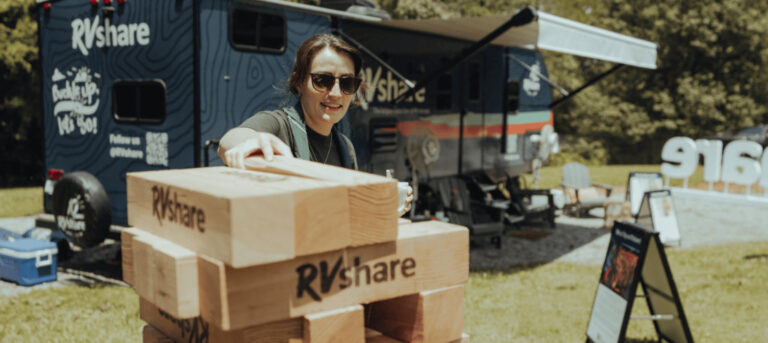
If you’ve been RVing for any amount of time, you’ve probably seen a few wrapped RVs driving down the road or sitting in a campground. Maybe you haven’t paid much attention to this, or maybe you’ve thought about getting our own RV wrapped.
If you’re in the latter camp, this is the article for you. Here we will discuss the various reasons to wrap your motorhome or trailer, RV wrap cost, and how long you might expect such a wrap to last.
How Much Does It Cost to Wrap an RV?
Wrapping an RV can cost anywhere from about $1,000 to $40,000 or even more. The final vinyl wrap RV cost depends on several factors, including the type and size of your motorhome or trailer, whether you’d like a full, three-quarter, or half wrap, and the material used to wrap the rig.
RV Wrap Cost Breakdown
| Item | Description | Cost |
|---|---|---|
| Travel Trailer Wraps | Half wrap on sides (28 ft x 8 ft) | $2,000 |
| Full wrap on sides (28 ft x 8 ft) | $4,000 | |
| Full wrap on front/back | $500 (each end) | |
| Half wrap on front/back | $250 (each end) | |
| Full front wrap (for fifth wheels) | $200 | |
| Motorhome Wraps | Wrap on sides | Comparable to trailer wraps |
| Wrap on windows | $100–$190 (per window) | |
| Wrap on slides | Around $250 (per slideout) | |
| Full wrap on front (class A) | $550 | |
| Full wrap on back (class A) | $825 | |
| Full back wrap (class C and B) | $550 | |
| Front wrap (class C and B) | Door and front fenders: $650 Cab overhang: $550 Hood: $240 | |
| Full wrap on 40 ft class A | $6,500-$7,000 |
Travel Trailer Wraps
Let’s take a look at travel trailer wraps specifically. A half wrap on just the sides of a 28-foot-long, 8-foot-tall trailer would cost somewhere around $2,000. Meanwhile, a full wrap on the sides of the same trailer would be double that cost. Those with fifth wheels will pay a bit more because these RVs are taller than bumper-pull trailers.
Want to add a wrap to the front and the back of the trailer? Expect to pay around $500 for a full wrap at each end of a travel trailer, regardless of the size of that trailer. As you might’ve guessed, a half wrap would be around half that price. As far as fifth wheels go, the back costs around the same, but the front of a fifth wheel will be cheaper to wrap, with a price point of about $200 for a full front wrap.
Wrapping slide outs will cost extra, as will wrapping windows, and design and shipping charges apply if you choose to use these services.
All-in-all, you can probably expect to pay something like $5000 to wrap a 28 foot travel trailer completely.
Motorhome Wraps
What about motorhome wraps? The cost of wrapping the sides of a motorhome is comparable to the trailer costs listed above. The cost of windows and slides is also the same at about $100–$190 per window depending on the location, and around $250 per slideout.
The only real difference in motorhome wrap pricing is for the front and back. For a class A motorhome, a full wrap of the front is about $550 and the back is around $825. When it comes to class C and class B motorhomes, a full back wrap falls into the $550 range, while the front is odd with a $650 price tag on the door and front fenders, $550 for the cab overhang, and $240 for the hood.
Hoping to fully wrap a 40 foot class A? Expect to spend at least $6500-$7000.
Why Wrap an RV?
First, we will discuss the number one reason one might choose to wrap their RV: appearances. An RV wrap will make your little home-on-wheels look sleek and clean, no matter how old it happens to be. Wrapping is also a great way to make your rig a memorable one, and might even make your RV into a nice conversation piece.
Your paint job could be fading or maybe you would like to advertise your business using your RV. Graphics and logos can be easily printed on vinyl wraps, making it look awesome while still protecting it from the elements.
RV Wrap vs Paint
If that’s the reason most people wrap their rigs, then why don’t they just give their respective RVs a good paint job and be done with it?
Well, to be honest, most of the time wrapping comes in at about a fraction of the price of a new paint job. Painting your RV will cost more due to the amount of preparation that goes in before the paint goes on. Not to mention, painting is permanent so you’ll have to take extra special care no to damage it and changing it out will involve lots of sanding.
On the other hand, RV wraps can be easily removed and replaced. They can also serve as a sort of armor, protecting the current paint job from scratches, dings, and the sun’s rays. Not only does this keep a new RV looking nice for years, it also helps preserve the resale value of your motorhome or travel trailer.
If the exterior of your RV has any noticeable damage to the current paint job, painting might be your best option. But, if your RV is in good shape with no body damage, a vinyl wrap is a cost-effective way to personalize and protect your rig.
How Long Does an RV Wrap Last?
Clearly, camper wraps don’t come cheap. Therefore, many people want to know how long their investment might last. The answer depends, of course, on the quality of the wrap you choose. High-quality RV graphic wraps should last at least 3–4 years, and some will last even longer if cared for properly.
Can I Wrap an RV Myself?
If you have the tools and know-how, yes, you absolutely can wrap your own RV. That said, those who don’t already know what they’re doing probably shouldn’t jump into this task, as messing up is easy to do, and a costly mistake besides.
Therefore, we highly recommend taking your RV to a professional to have it wrapped if you have any doubts whatsoever. A professional installer will make sure the job is done correctly, as they know how to properly measure, cut, smooth, and seal your wrap.
Hopefully this article helped you understand the benefits of an RV wrap. Another benefit of a wrapped RV? It’ll look really spiffy, meaning it’ll likely work well as a rental RV. Why not list your wrapped RV for rent today?






